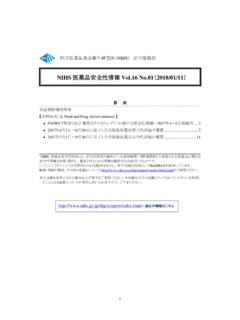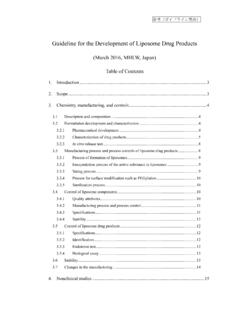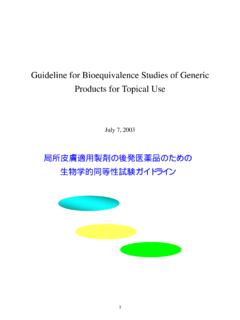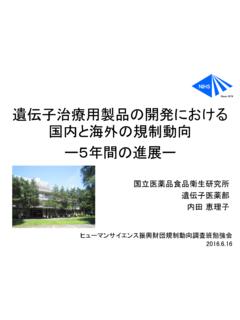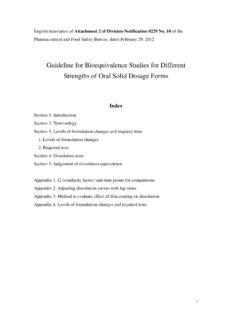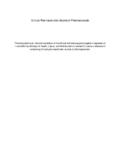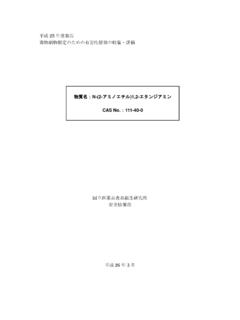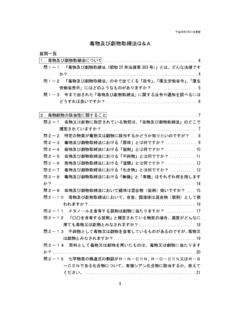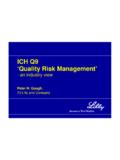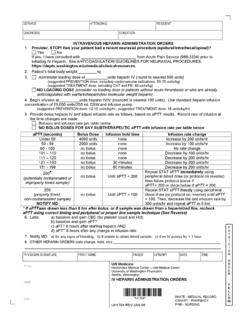Transcription of Pharmacopeial Forum Vol. 35(5) [Sept.–Oct. 2009] …
1 Changetoread: heparin Sodium is the sodium salt of sulfated glycosami-noglycans present as a mixture of heterogeneous moleculesvarying in molecular weights that retains a combination ofactivities against different factors of the blood clotting is present in mammalian tissues and is usually obtained fromthe intestinal mucosa or other suitable tissues of domesticmammals used for food by man. The sourcing of heparinmaterial must be specified in compliance with applicableregulatory requirements. The manufacturing process should bevalidated to demonstrate clearance and inactivation of relevantinfectious and adventitious agents ( , viruses, TSE agents).SeeViral Safety Evaluation of Biotechnology Products Derived fromCell Lines of Human or Animal Originh1050ifor generalguidance on viral safety evaluation. It is composed of polymersof alternating derivatives ofa-D-glucosamido (N-sulfated,O-sulfated, orN-acetylated) andO-sulfated uronic acid (a-L-iduronic acid orb-D-glucuronic acid).
2 The component activitiesof the mixture are in ratios corresponding to those shown bythe USP heparin Sodium for Assays RS. Some of thesecomponents have the property of prolonging the clottingtime of blood. This occurs mainly through the formation of acomplex of each component with the plasma proteinsantithrombin and heparin cofactor II to potentiate theinactivation of thrombin (factor IIa). Other coagulationproteases in the clotting sequence, such as activated factor X(factor Xa), are also inhibited. The ratio of anti-factor Xaactivity to anti-factor IIa potency is between and Thepotency of heparin Sodium, calculated on the dried basis, isNLT 180 USP heparin Units in each NMR SPECTRUM(SeeNuclear Magnetic Resonanceh761i.)Standard solution:NLT 20 mg/mL of USP HeparinSodium Identification RS in deuterium oxide with (w/v) deuterated trimethylsilylpropionic (TSP) acid sodium saltSystem suitability solution:Prepare 1% (w/w) USPO versulfated Chondroitin Sulfate RS inStandard solution:NLT 20 mg/mL of heparin Sodium indeuterium oxide with (w/v) deuterated TSPA nalysisSamples:Standard solutionandSystem suitability solutionUsing a pulsed (Fourier transform) NMR spectrometeroperating at NLT 500 MHz for1H, acquire a free inductiondecay (FID) using NLT 16 scans using a 908pulse and 20s delay.
3 Record the1H NMR spectra of theStandard solutionandSystem suitability solutionat 258. Collect the1H NMRspectrum with a spectral window of at least 10 to 2 ppm andwithout spinning. The number of transients should be adjusteduntil the signal-to-noise ratio of theN-acetyl heparin signal intheStandard solutionis at least 1000/1 in the region near2 ppm. TheStandard solutionshall be run at least daily whenSample solutionsare being run. For all samples, the TSP methylsignal should be set to ppm. The chemical shift for theN-acetyl resonance of heparin and oversulfated chondroitinsulfate in theSystem suitability solutionshould be observed + and + ppm, respectively. Record the1 HNMR spectrum of theSample solutionat 258. Draw a baselinefrom ppm to ppm. The ppm values for H1 ofGlcNAc/GlcNS, 6S (signal 1), H1 of IdoA2S (signal 2), the H2 ofGlcNS (signal 3), and the methyl of GlcNAc (signal 4) ofheparin are present at , , (doublet centered ppm), and ppm, ppm values ofthese signals do not differ by more than+ ppm.
4 Measurethe signal heights above the baseline of signal 1 and signal 2,and calculate the mean of these signal heights. Other signals ofvariable heights and ppm values, attributable to heparin andHOD, may be seen between signal 2 and ppm. Residualsolvent signals may be observed in the Sodium must meet the requirements stated criteria:No unidentified signals greaterthan 4% of the mean of signal height of 1 and 2 are presentin the following ranges: , , and No signals greater than 200% signal height of the meanof the signal height of 1 and 2 are present in the for porcine heparin . B. CHROMATOGRAPHICIDENTITYS olution A:Dissolve of monobasic sodium phos-phate dihydrate in 2 L of water and adjust with phosphoricacid to a pH of Filter the solution through a and degas prior to B:Dissolve of monobasic sodium phos-phate dihydrate and 280g of sodium perchlorate monohy-drate in 2 L of water and adjust with phosphoric acid to a pH Filter the solution through a membrane anddegas prior to phase:See the gradient table (min)Solution A(%)Solution B(%)Elution08020 Equilibration601090 Linear gradient618020 Linear gradient758020Re-equilibrationStandard solution:NLT 20 mg/mL of USP HeparinSodium Identification RS in waterSystem suitability solution:Prepare 1% (w/w) USPO versulfated Chondroitin Sulfate RS and 1% (w/w) USPD ermatan Sulfate RS inStandard solution.
5 NLT 20 mg/mL of heparin Sodium inwaterChromatographic system(SeeChromatographyh621i, System Suitability.)Mode:LCDetector:UV 202 nmColumn:2-mm625-cm; packing L61 Guard column:2-mm650-mm; packing L61 Column temperature:Maintain columns at 408 Flow mL/minInjection size:10mLSystem suitabilitySample:System suitability solutionNOTE The retention times for dermatan sulfate, heparin , andoversulfated chondroitin sulfate are about 20, 30, and 50 min, requirementsResolution:NLT between the dermatan sulfate andthe heparin peaks, and NLT between the heparin and theoversulfated chondroitin sulfateRelative standard deviation:NMT 2% for the heparinpeak determined from three replicate injectionsAnalysisSamples:Standard solutionandSample solutionRecord the chromatograms, and measure the retentiontimes for the major criteria:The retention time of the majorpeak from theSample solutioncorresponds to that from theStandard solution.
6 C. ANTI-FACTORXaTOANTI-FACTORIIa RATIOAnti-factor Xa activitypH buffer:Dissolve amounts of tris(hydroxymeth- yl)aminomethane, edetic acid, and sodium chloride in watercontaining of polyethylene glycol 6000 to obtain asolution having concentrations of , , , respectively. Adjust, if necessary, with hydrochloricacid or sodium hydroxide solution to a pH of ,N-acetylated glucosamine; GlcNS,N-sulfated gluco-samine; S, Sulfate; IdoA, iduronic acid; GlcN, glucosamine;GalN, 1 of 7 Time:12:06 Date:7/7/09 Instance: G:/PF/Production/ Template:S:/PF/Template/PFRedesign/PF353 #2009 The United States Pharmacopeial ConventionAll Rights ForumVol. 35(5) [Sept. Oct. 2009] INTERIM REVISION ANNOUNCEMENT1 Antithrombin solution:Reconstitute a vial of anti-thrombin (seeReagents, Indicators, and Solutions ReagentSpecifications) as directed by the manufacturer, and furtherdilute withpH bufferto obtain a solution having aconcentration of Antithrombin Xa solution:Reconstitute bovine factor Xa asdirected by the manufacturer (seeFactor XainReagents,Indicators, and Solutions Reagent Specifications), and furtherdilute inpH bufferto obtain a solution that gives anabsorbance value between and at 405 nm whenassayed as described below but using 30mL ofpH bufferinstead of 30mL of theStandard solutionsor theSamplesolutions.
7 [NOTE Factor Xa solutioncontains about 3 nanokata-lytic units/mL, but can vary depending upon the manufacturerof factor Xa or the substrate used.]Chromogenic substrate solution:Prepare a solution ofa suitable chromogenic substrate for amidolytic test (seeReagents, Indicators, and Solutions Reagent Specifications)specific for factor Xa in water to obtain a concentration of1 solution:20% (v/v) solution of acetic acidStandard solutions:Reconstitute the entire contents ofan ampule of USP heparin Sodium for Assays RS with water,and dilute withpH bufferto obtain at least 5 dilutions in theconcentration range between and USP solutions:Dissolve or dilute an accuratelymeasured quantity of heparin Sodium inpH buffer, anddilute with the same buffer to obtain solutions having activitiesapproximately equal to those of theStandard The procedure can also be performed using alterna-tive platforms.
8 Perform the test with eachStandard solutionandSample solutionin each of a series of suitable plastic tubes placed in a waterbath set at 378, transfer 120mL ofpH buffer. Thenseparately transfer 30mL of the different dilutions of theStandard solutionsor theSample solutionsto the tubes. Add150mL ofAntithrombin solution, prewarmed at 378for 15 min,to each tube, mix, and incubate for 2 min. Add 300mL ofFactor Xa solution, prewarmed at 378for 15 min, to each tube,mix, and incubate for 2 min. Add 300mL ofChromogenicsubstrate solution, prewarmed at 378for 15 min, to each tube,mix, and incubate for exactly 2 min. Add 150mL ofStoppingsolutionto each tube, and mix. Prepare a blank for zeroing thespectrophotometer by adding the reagents in reverse order,starting with theStopping solutionand ending with theaddition of 150mL ofpH buffer, and excluding theStandard solutionsor theSample solutions.
9 Record theabsorbance at 405 nm against the :Plot the log of the absorbance values of theStandard solutionsand theSample solutionsversus heparinconcentrations in USP Units. Calculate the activity of HeparinSodium in USP Units/mg using statistical methods for sloperatio assays. Calculate the anti-factor Xa activity of HeparinSodium by the formula:A6(ST/SS)A = the potency of USP heparin Sodium for Assays RSST= slope of the line for theSample solutionsSS= slope of the line for theStandard solutionsExpress the anti-factor Xa activity of theSample solutionasUSP heparin Units/mg, calculated on the dried basis. Calculatethe ratio of anti-factor Xa activity against anti-factor IIapotency (seeAssaybelow) by the formula:anti-factor Xa activity/anti-factor IIa potencyAcceptance criteria:NLT and NMT D. IDENTIFICATIONTESTS GENERAL,SODIUMh191i:Itmeets the requirements of the flame test for ANTI-FACTORIIa POTENCYpH buffer:Dissolve of tris(hydroxymethyl)a-minomethane, of sodium chloride, of edetatesodium, and, if suitable, between 0 and of polyeth-ylene glycol 6000 and/or of bovine serum albumin in800 mL of water.
10 [NOTE of human albumin may besubstituted for of bovine serum albumin.] Adjust withhydrochloric acid to a pH of , and dilute with water to solution:Reconstitute a vial of anti-thrombin (seeReagents, Indicators, and Solutions ReagentSpecifications) in water to obtain a solution of 5 AntithrombinIU/mL. Dilute this solution withpH bufferto obtain asolution having a concentration of Antithrombin human solution:Reconstitute thrombin hu-man (factor IIa) (seeReagents, Indicators, and Solutions Reagent Specifications) in water to give 20 Thrombin IU/mL,and dilute withpH bufferto obtain a solution having aconcentration of 5 Thrombin IU/mL. [NOTE The thrombinshould have a specific activity of NLT 750 IU/mg.]Chromogenic substrate solution:Prepare a solution ofa suitable chromogenic thrombin substrate for amidolytic test(seeReagents, Indicators, and Solutions Reagent Specifications)in water to obtain a concentration of solution:20% (v/v) solution of acetic acidStandard solutions:Reconstitute the entire contents ofan ampule of USP heparin Sodium for Assays RS with waterand dilute withpH bufferto obtain at least four dilutions inthe concentration range between and USP solutions:Proceed as directed forStandardsolutionsto obtain concentrations of heparin Sodium similarto those obtained for theStandard [NOTE The procedure can also be performed using alterna-tive platforms.]
